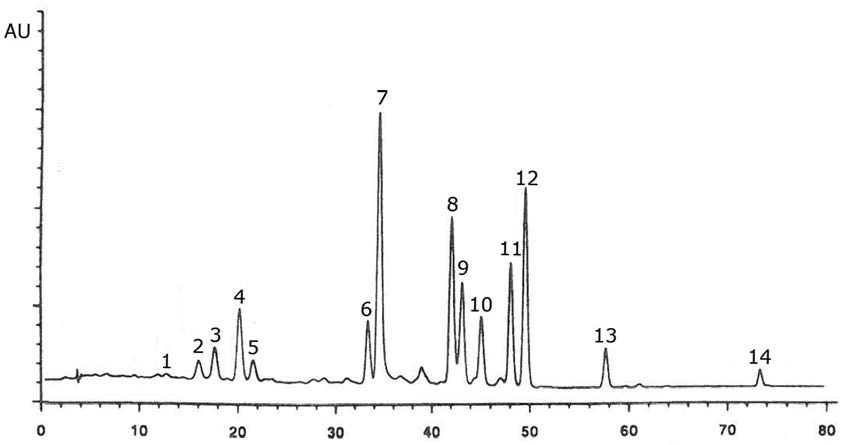Compounds of the Carotenoid Family Retained
These compounds are very lipophilic and often have subtle differences in structure. Resolution of these compounds can be difficult with a standard Reversed Phase C8 or C18 Column because of these Similarities. The Cogent C30 Column on the other hand can further differentiate by analyte Shape in addition to Reversed Phase Interactions. At lower temperatures, the long alkyl chains become more rigid and steric effects become significant, leading to greater Selectivity.
Peaks:
1. Astaxanthin
2. Capsanthin
3. Lutein
4. Zeaxanthin
5. Canthaxanthin
6. ß-Kryptoxanthin
7. Echinenone
8. 15-cis ß-Carotene
9. 13-cis ß-Carotene
10. a-Carotene
11. trans ß-Carotene
12. 9-cis ß-Carotene
13. d-Carotene
14. Lycopene
Method Conditions:
Column: Cogent C30™, 5µm, 200Å
Catalog No.:72530-25P
Dimensions: 4.6 x 250mm
Mobile Phase:
—A: 81:15:4 Methanol / Methyl Tert-Butyl Ether / DI Water (v/v)
—B: 6:90:4 Methanol / Methyl Tert-Butyl Ether / DI Water (v/v)
Gradient:
| Time (minutes) | %B |
| 0 | 0 |
| 90 | 100 |
Temperature: 20°C
Flow rate: 1.0ml / minute
Detection: UV @ 450nm
Sample Preparation: Reference Standards of each Analyte in a mixture.
Notes: Carotenoids are a broad class of more than 600 compounds. They can be divided into two types: Xanthophylls and Carotenes. Xanthophylls contain oxygen in their structure and get their name from the Greek words Xanthos (yellow) and Phyllon (leaf). Carotenes are unsaturated hydrocarbons which do not contain other elements in their structure.
Attachment
No 262 Carotenoids Analyzed with HPLC pdf 0.2 Mb Download File



